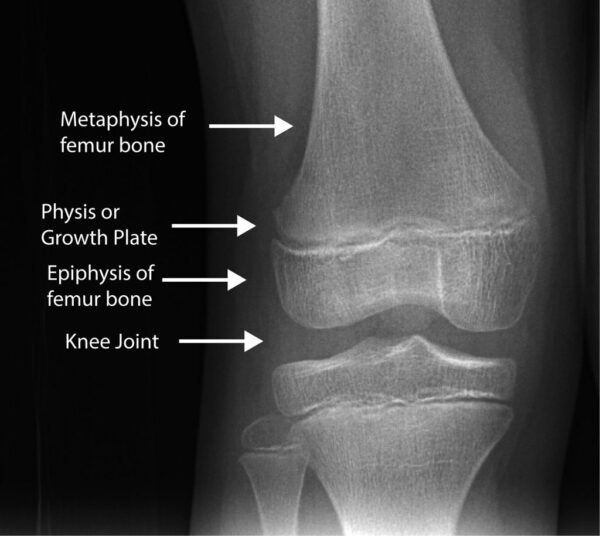Height is undoubtedly one of the most conspicuous physical attributes of human beings. Other than making us literally stand out from the crowd, a good height also comes with many benefits – from boosting our self-confidence and self-esteem to increasing our attractiveness, giving us an advantage in sports, and supporting our careers. No wonder most of us, if not all, desire to at least reach a socially acceptable height. Those nearing the end of their puberty cannot help but ponder whether they are finished with growing or they still have time to make those “height genes” work. Is it possible to grow taller at 17? Keep reading to find out!
Can I grow taller at 17? Ask your growth plates first!
Indeed, growth plates or epiphyseal plates are hyaline cartilage parts in the metaphysis at the ends of your long bones. While your existing bone tissue constantly performs bone remodeling and maintenance, new bone growth takes place at the growth plates. In other words, it is where your long bones add length or grow longer.
Growth plates are unfortunately only present in children and teenagers. Due to growth plate fusion or epiphyseal closure, the growth plates in adults who have stopped growing are replaced by epiphyseal lines. Complete closure occurs on average between ages 18-22 for males and 15-18 for females [1]. After this closure, you have reached your final adult height and can no longer increase height naturally.

At 17, some people have already gone through puberty while others are still struggling with it. If you find yourself in the former group, then you are highly unlikely to add inches to your height anymore. On the other hand, for late bloomers who are in the middle or near the end of puberty at 17, chances are your growth plates have not fused yet and you can grow taller naturally.
To make the most of your little time left to grow taller at 17, it is vitally important to leverage factors influencing your height growth, namely nutrition, sleep, exercise, and living environment. They are influential upon your growing process throughout childhood and adolescence; as a result, if you want to grow taller at 17 and achieve your desired height, taking care of these factors will do.
Eat well for height increasing
Malnutrition is often the cause of stunted growth among children and teenagers. Hence, you need to maintain a balanced diet that includes all of the essential nutrients to maximize your height potential. In this respect, emphasis should be placed on the supply of vitamin D, protein, and other bone-building minerals such as calcium and zinc. As foods to the bones, these nutrients not only add more strength and length to your bones but also promote the development of muscles, thereby ensuring that your height growth is optimal and healthy.

Check out the list of foods that help you grow taller here.
Exercise to grow taller at 17
You are not required to do rigorous physical activities. Instead, any exercises that keep you active such as skipping, hanging, or jumping are useful in promoting your height. A good skipping rope is a worthwhile investment and can help you achieve your height goal.

Should those exercises sound dull to you, you can try swimming or basketball. Swimming is inarguably one of the most effective ways to increase height and stay fit. It enhances your bone elasticity and increases the body’s vertical length naturally. Breaststroke swimming, in particular, can help you grow taller at 17 efficiently by exerting pressure on the midriff, which gradually distributes the stress throughout your body and increases your height further.
Regarding basketball, while channeling your inner Michael Jordan on the court, you stress your muscles and exert pressure on your whole body. These stretching and pulling movements of your muscles and joints both trigger growth hormone production and promote flexibility. You can expect a better height with regular practice over time.
Get good and enough sleep
According to research, it is during the phase of deep sleep that human growth hormone is secreted at peak levels. For this reason, if you desire to grow taller at 17, the easiest and simplest way is to ensure you are getting enough good-quality sleep. Ideally, at least 8 hours of sleep per night is recommended for people under the age of 20 to maintain optimal health and grow to their full potential. Leading an active lifestyle with lots of physical effort can help you have sound sleep at night.
Do not stay up late frequently and make sure that your room, especially the bed, is comfortable enough for you to sleep tight.
Avoid too much fatty and salty food
Want to grow taller at 17? Limit your intake of unhealthy foods such as burgers, pies, takeaway pizzas, potato chips, hot chips, cakes, lollies, doughnuts, biscuits, and pastries. These junk foods are high in saturated fat, salt, and sugar while low in fiber. Teenagers who eat these foods on a regular basis are at a higher risk of overweight, obesity, and type-2 diabetes.

In addition to foods, unhealthy drinks like soft drinks should also be avoided as they are low in nutrients but high in sugar. Overindulgence in these would cost you your precious chance of reaching your maximum potential height. Instead, you can switch to healthier alternatives including nuts, fresh fruits, vegetables, or low-fat yogurt whenever you crave some snacks.
Adjust your posture
The curvature of your spine is negatively affected by slouching or hunching over. Good posture, on the contrary, keeps your spine and body straight for proper bone growth and height gain. Therefore, do not slouch or hunch over while standing and walking to grow taller at 17. Make sure you sit upright when sitting on a chair. Be mindful of your posture; you will be surprised by the positive effect on your height!
Drink plenty of water
Weird, isn’t it? What can a glass of plain water do other than quenching your thirst?

One glass cannot make you grow taller at 17 of course, but drinking a minimum of eight glasses of water a day helps flush out toxins from your body and eliminate various diseases. Research suggests that people in their growing years should consume adequate water to strengthen the immune system and regulate the normal functioning of different body parts [2]. Sufficient water supply also ensures proper metabolism for nutrients to be quickly and efficiently absorbed into your body, thus accelerating your height increase and improving your overall health.
Maintain an ideal weight
It is easy to overlook this aspect when investing in your height growth. However, your body weight plays a bigger role in determining your final adult height more than you thought.
An unhealthy weight can stunt your growth in that the surplus of body weight puts excessive pressure on your bones and joints as well as the intervertebral discs between your spine. This would deform your posture and eventually make you shorter than your genetically predetermined height. Keeping a check on your diet to ensure a healthy weight is utterly crucial for you to grow taller at 17.
REFERENCES
[1] https://www.astm.org/DIGITAL_LIBRARY/JOURNALS/FORENSIC/PAGES/JFS2004542.htm [2] https://www.betterhealth.vic.gov.au/health/HealthyLiving/teenagers-and-sleepFAQs
Milk is a good source of calcium, which is essential for bone growth and development. However, it's important to consume a well-balanced diet that includes other sources of calcium, as well as other essential vitamins and minerals.
Certain supplements, such as vitamin D and calcium, are essential for proper growth and development. However, it's important to talk to your doctor before taking any supplements, as they can have potential risks and side effects.
Practicing good posture by standing up straight, with your shoulders back and your chin up, can improve spinal alignment and lead to a slight increase in height. However, it's unlikely to significantly impact overall height.
